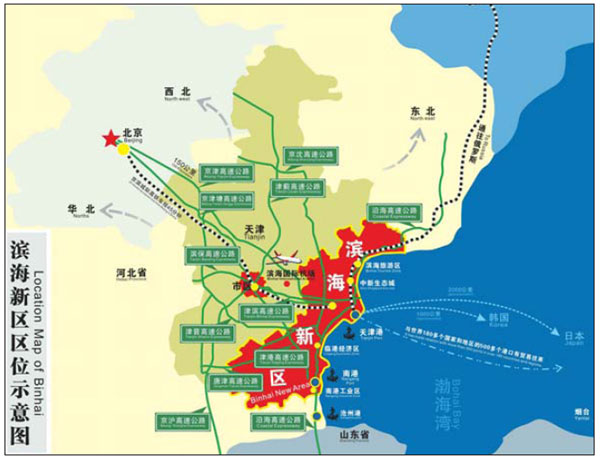Binhai's new green development already taking root
Updated: 2013-09-15 07:36
By Fu Chao(China Daily)
|
|||||||
Putting theory into practice, the Binhai New Area, host of the China International Eco-city Forum and Expo, will complete construction in 2020 of its livable eco-community now under development, said local officials.
The Binhai New Area was first listed as a major national development project in the country's 11th Five-Year Plan (2006-10) as a base for modern manufacturing as well as international shipping and logistic center for North China.
The latest plan aims to gradually transform the area into a livable eco-community with a prosperous economy and beautiful living environment.
The future "beautiful Binhai" will be measured by a variety of targets in 2016: 1.2 trillion yuan ($196.7 billion) in gross regional product with service industries accounting for 35 percent and strategic emerging industries more than 40 percent. Research and development should be funded by 3.1 percent of the total output of the area.
Energy consumption is targeted to decline by 20 percent and emissions by more than 20 percent for every 10,000 yuan in economic output.
The plan also calls for forest and semi-natural areas to cover 10.5 percent of the land while 95 percent of the wastewater in the city will be treated and 98 percent of the city's garbage disposed of without causing harm.
Officials said all of the targets have only one ultimate goal - to become the first successful case and role model for eco-civilization development in China.
And the area already has some remarkable achievements.
"We have taken the support from the country as an opportunity to work on the 'green business' - green industries, green building and a green way of living - and have built a lovely eco-city with blue sky and green water," said Yang Shihao, deputy chief of Binhai New Area.
To create a low-carbon environment for the new area, the eco-city has worked out a set of regulations to control energy consumption.
Regulations say the eco-city should only use clean energy, 20 percent of it renewable.
A resident of Wantong Xinxin Garden in the eco-city said that he can save 750 yuan a year in electricity bills by using solar energy.
He has been living in the development for only a few months but is impressed with the "greenness".
It is not only green but also clean. The eco-city has completely cleared a waste reservoir of industrial pollution. The technology used has since been patented.
Today, the huge waste reservoir has become a beautiful lake.
After five-year efforts in building the country's first eco-city, the Binhai New Area has already become something of a role model.
In a nod to its accomplishments, in March the State Council officially approved the development of the first National Ecological Demonstration Area in Binhai.
fuchao@chinadaily.com.cn

(China Daily 09/15/2013 page8)